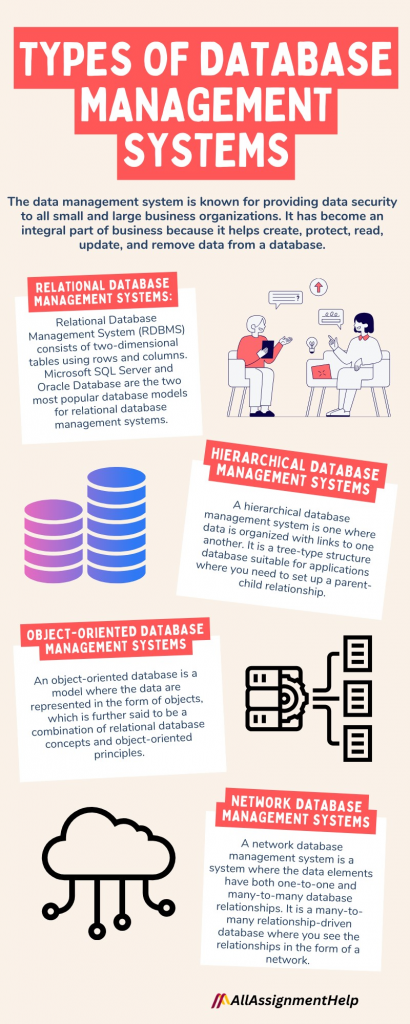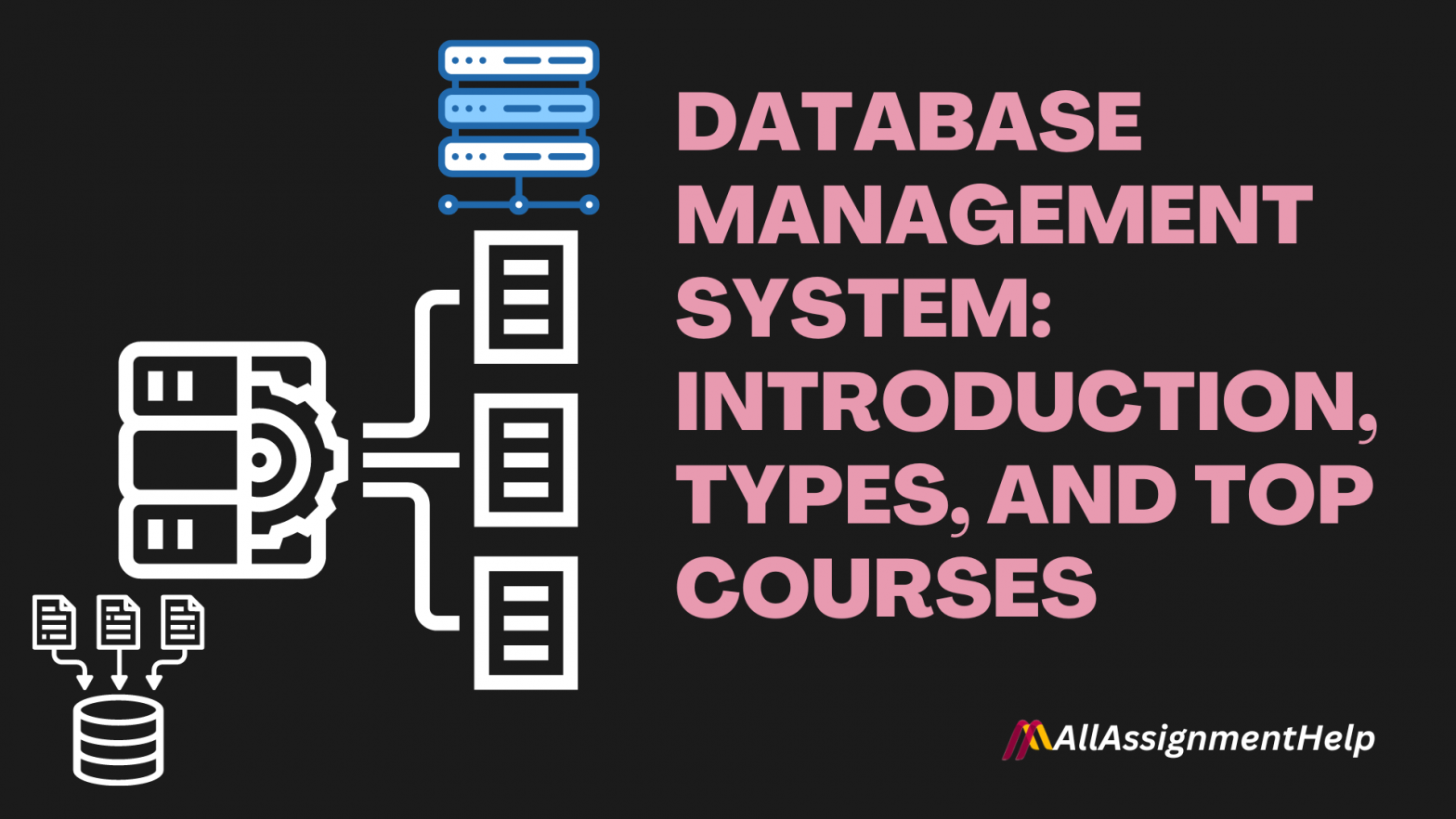Table of Contents
A database management system, also known as a DBMS, is an expert software program utilized to manipulate, enable, and maintain clients to organize, store, access, retrieve, modify, secure, and provide information integrity to the database. A database management system generally manipulates the data itself, the data format, field names, record structures, and file structures. Additionally, it defines the rules to validate and manipulate the data.
DBMS is based on specific data handling concepts as the practice of administering a database evolves. At the earliest, database management systems only handled individual, single pieces of specially formatted data. However, today, more evolved systems can handle different kinds of less formatted data and tie them together more elaborately. It is known to be the only connection between the databases and the end users or application programs. This blog post from the experts at AllAssignmentHelp.com explains more about DBMS functions, benefits, types, and more.
Database Management System: An Introduction to Its Workings and Purposes
If we talk about the workings of a database management system, it mostly manages the data. A DBMS is also known to preserve data consistency and data warehousing when there are many users. The DBMS can also solve troubleshooting issues if the DB statistics are up-to-date. Following this, we have listed some other workings of the database management system to help you understand more about this term.
- The database engine allows the data to be accessed, locked, and modified. Additionally, the database management schema defines the database’s logical structure.
- The three foundational elements help provide concurrency, security, data integrity, and uniform data administration procedures.
- The typical database administration tasks the DBMS supports include change management, performance monitoring and tuning, security, and backup.
- Most database management systems are also responsible for automated rollbacks and restarts, as well as logging and auditing of the activities in the database and the applications that access them.
- Database can provide a centralized view of the data that can be accessed by multiple users from different locations. This can be done in a controlled manner.
- A DBMS can also limit the information that the end-user can see. Also, it can manage the information about how the end-user will view the data. Additionally, it provides different views of single database management.
- A RDBMS is adaptable to most of the used cases, but RDBMS tier-1 products can be quite expensive for people.
- An in-memory database management system (IMDBMS) provides faster response times and better performance but can consume more resources.
- A columnar database management system is built and accessed through the cloud, and the cloud service provider is responsible for providing and maintaining the DBMS.
- DBMS is software used to store, retrieve, and run queries on data and plays a vital role in information systems.
What are the Various Types of Database Management Systems?
The data management system is known for providing data security to all small and large business organizations. It has become an integral part of business because it helps create, protect, read, update, and remove data from a database. With the use of data in business, the future of database management systems is safe, and we can expect many new things. This demand is never going to fade away. Blockchain for secure database transactions is one of the major trends and innovations in DBMS.

The database management system is an integral part of business; hence, you should first understand what type of database management system is suitable for your project. The following are the different DBMS types:
1- Relational Database Management Systems:
- Relational Database Management System (RDBMS) consists of two-dimensional tables using rows and columns. Microsoft SQL Server and Oracle Database are the two most popular database models for relational database management systems. Tuples and attributes, or fields, are the two key traits of the relational model, which help form the fundamental building blocks and uniquely identify each record.
- It is one of the areas where you can expect lots of university assignments. This includes writing MySQL queries, creating database tables, normalizing the database, and finding vulnerabilities. This is the area where students often feel the need to seek database management assignment help. By hiring a database management assignment helper, they get the advantage of submitting a well-written and advanced database assignment.
2- Hierarchical Database Management Systems:
- A hierarchical database management system is one where data is organized with links to one another. It is a tree-type structure database suitable for applications where you need to set up a parent-child relationship. One-to-many relationships, parent-child relationships, deletion problems, and pointers are the four characteristics of the hiring DBMS model.
- The hierarchy of every database starts with one root node, and it further connects with other related factors. Let us give you an example to help you understand this term better. For example, if you are preparing a hiring database for a college, the supporting parties will be students, teachers, administration officers, college heads, and others. Further students can be connected with age, roll number, name, standards, and grades.
Also Read: Study Smart Instead of Studying Hard
3- Object-Oriented Database Management Systems:
- An object-oriented database is a model where the data are represented in the form of objects, which is further said to be a combination of relational database concepts and object-oriented principles.
- Object-oriented programming consists of data encapsulation, inheritance, and polymorphism. This database management system uses less code and is easier to maintain as compared to others. However, it still offers top features like security, integrity, concurrency, processing, and transactions.
- Based on the concepts of object-oriented programming, it mimics real-world objects in database design.
4- Network Database Management Systems:
- A network database management system is a system where the data elements have both one-to-one and many-to-many database relationships. It is a many-to-many relationship-driven database where you see the relationships in the form of a network.
- This database model follows the hiring model, where one child is allowed to have different parents. For example, a student learns different types of subjects in their class from different teachers. In this sense, he or she is assumed to have different parents in the form of a teacher. All the data is organized here in the form of a graph using sets of related records.
- increased capacity for relationship fusion, several paths, and a linked circular list are a few of the features of this model, which implies multiple parent records.
Do you think that these concepts are detailed and that it is hard to pass on the entire information in your assignment? Do you face several challenges, such as massive pressure, performance evaluation, and tight deadlines, during your academic years? If yes, you should get college assignment help and learn more about the coursework and concepts of databases. The professional helpers will provide you with much-needed help and reduce your stress.
What Can One Learn With a Database Management System Course?
Database Management System is one of the top courses with which you can learn everything about how you can provide security features that protect data from unauthorized access. The following are some of the things you will learn in the DBMS course.
- Collect website entities: You need to first create use-case diagrams to figure out the different sub-systems of a website. It means login, logout, and functionalities related to search and processes.
- Make an Entity Relationship Diagram: So, once you have established a relationship between the system and user interaction, you need to make an ERD to figure out relationships between different entities of the system. Also, it helps you see the constraints between the entities.
- Move ERD to Physical Database Design: Once you have an ERD verified after a few dry runs, you need to start creating a physical database design.
- Create database tables and normalize the database: However, you need to create database tables and normalize the tables for the best output. You reduce redundant entries and duplicates using normalization (1NF, 2NF, and 3NF).
- Set up a connection between your database and the front-end application: Once you have all the Structured Query Language (SQL) queries in place to meet your functionalities, you write code to connect the database with the front-end application. You can develop the front end using PHP, Java programming, Java Servlet, ASP.NET, React JS, Angular JS, and Node.js.
- Launch the application: You can use an Apache server to host your application in connection with a MySQL server to complete your website development assignment.
Also Read: Which one is suitable for you – MBA VS M.Tech
The Top Database Management System Course
Do you know that there are different uses of DBMS, like database management system for healthcare, database management systems for business intelligence, backup and recovery, and other areas? A database is something you cannot live without when you are working in an IT domain. Every single application is created around database systems. Moreover, the quality of an application is checked based on how the database has been optimized. The following are some of the DBMS courses offered by top institutions and universities.
- Introduction to Relational Databases (RDBMS) offered by IBM
- Database Management Essentials offered by University of Colorado Systems
- Learn SQL Basics for Data Science Specialization offered by the University of California
- Introduction to Databases offered by Meta
- BCA in Database Management System
- Introduction to databases
- Business Analytics and Big Data MSc
- Data Analytics and Human Resource Management MSc
- Introduction to Data Analytics Course
- Data Manipulation with Python
Finding a challenging new career path and selecting a new database management system course won’t be easy. At times, you may also want to hire someone to take your online class to reduce your academic struggles and pressure. If you think so without any hesitation, move forward, as at the end of the day, top grades are important for any online or offline course.
About Us
At All Assignment Help, students can find the best academic help at an affordable price. Our team has professionals with relevant industry experience who provide students with the best Java assignment help and website design and development assignment help. If you are looking for assignment help from qualified professionals, you can get in touch with our experts. They can help you with all your assignments and make sure you get top grades in all of them.
The following are some of the features of our instant assignment help service:
- Plagiarism-free work
- 24*7 assignment help
- Free revisions
- Affordable price
- High-quality assignments
Frequently Asked Questions
| Question 1: Which is the best database management system for small businesses? Answer 1: PostgreSQL, Oracle Database, SQL Connector for JIRA, Quickbase, ClickUp, Microsoft SQL Server, Kintone, Zoho Creator, MySQL, and Caspio are the top ten DBMS that one can use in their small business. |
| Question 2: How to choose the right database for your needs? Answer 2: Data type, scalability, security, integration, and analytics capabilities are the five factors that you should consider when selecting a database. You should also understand your data’s characteristics to make the right choice for you. |
